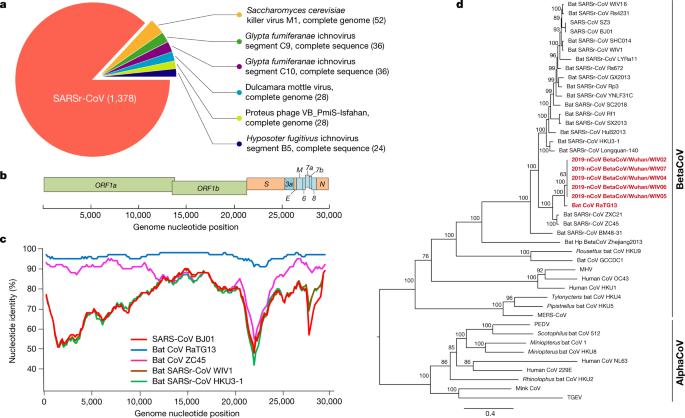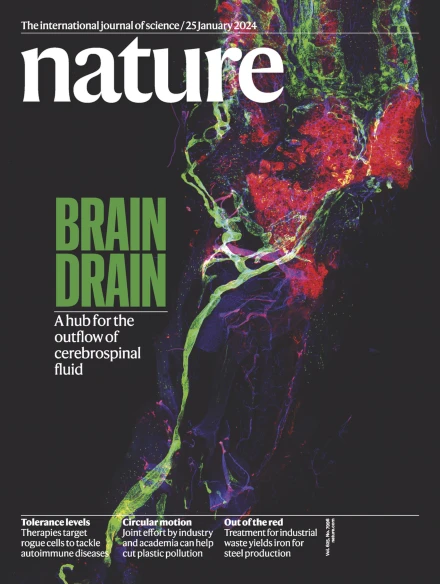A pneumonia outbreak associated with a new coronavirus of probable bat origin
IF 50.5
1区 综合性期刊
Q1 MULTIDISCIPLINARY SCIENCES
引用次数: 17458
Abstract
Since the outbreak of severe acute respiratory syndrome (SARS) 18 years ago, a large number of SARS-related coronaviruses (SARSr-CoVs) have been discovered in their natural reservoir host, bats1–4. Previous studies have shown that some bat SARSr-CoVs have the potential to infect humans5–7. Here we report the identification and characterization of a new coronavirus (2019-nCoV), which caused an epidemic of acute respiratory syndrome in humans in Wuhan, China. The epidemic, which started on 12 December 2019, had caused 2,794 laboratory-confirmed infections including 80 deaths by 26 January 2020. Full-length genome sequences were obtained from five patients at an early stage of the outbreak. The sequences are almost identical and share 79.6% sequence identity to SARS-CoV. Furthermore, we show that 2019-nCoV is 96% identical at the whole-genome level to a bat coronavirus. Pairwise protein sequence analysis of seven conserved non-structural proteins domains show that this virus belongs to the species of SARSr-CoV. In addition, 2019-nCoV virus isolated from the bronchoalveolar lavage fluid of a critically ill patient could be neutralized by sera from several patients. Notably, we confirmed that 2019-nCoV uses the same cell entry receptor—angiotensin converting enzyme II (ACE2)—as SARS-CoV. Characterization of full-length genome sequences from patients infected with a new coronavirus (2019-nCoV) shows that the sequences are nearly identical and indicates that the virus is related to a bat coronavirus.

与一种可能源于蝙蝠的新型冠状病毒有关的肺炎爆发
自 18 年前爆发严重急性呼吸系统综合症(SARS)以来,人们在其天然宿主蝙蝠体内发现了大量与 SARS 相关的冠状病毒(SARSr-CoVs)1-4。以前的研究表明,一些蝙蝠 SARSr-CoVs 有可能感染人类5-7。在此,我们报告了一种新型冠状病毒(2019-nCoV)的鉴定和特征描述。疫情始于 2019 年 12 月 12 日,截至 2020 年 1 月 26 日,已造成 2794 例实验室确诊感染病例,其中 80 人死亡。在疫情爆发的早期阶段,从五名患者身上获得了全长基因组序列。这些序列几乎完全相同,与 SARS-CoV 有 79.6% 的序列相同性。此外,我们还发现 2019-nCoV 在全基因组水平上与蝙蝠冠状病毒有 96% 的相同性。对7个保守的非结构蛋白结构域的蛋白质序列分析表明,该病毒属于SARSr-CoV种。此外,从一名重症患者的支气管肺泡灌洗液中分离出的 2019-nCoV 病毒可被多名患者的血清中和。值得注意的是,我们证实 2019-nCoV 与 SARS-CoV 使用相同的细胞进入受体--血管紧张素转换酶 II (ACE2)。对感染新型冠状病毒(2019-nCoV)的患者的全长基因组序列进行的特征分析显示,这些序列几乎完全相同,表明该病毒与蝙蝠冠状病毒有关。
本文章由计算机程序翻译,如有差异,请以英文原文为准。
求助全文
约1分钟内获得全文
求助全文
来源期刊

Nature
综合性期刊-综合性期刊
CiteScore
90.00
自引率
1.20%
发文量
3652
审稿时长
3 months
期刊介绍:
Nature is a prestigious international journal that publishes peer-reviewed research in various scientific and technological fields. The selection of articles is based on criteria such as originality, importance, interdisciplinary relevance, timeliness, accessibility, elegance, and surprising conclusions. In addition to showcasing significant scientific advances, Nature delivers rapid, authoritative, insightful news, and interpretation of current and upcoming trends impacting science, scientists, and the broader public. The journal serves a dual purpose: firstly, to promptly share noteworthy scientific advances and foster discussions among scientists, and secondly, to ensure the swift dissemination of scientific results globally, emphasizing their significance for knowledge, culture, and daily life.
 求助内容:
求助内容: 应助结果提醒方式:
应助结果提醒方式:


